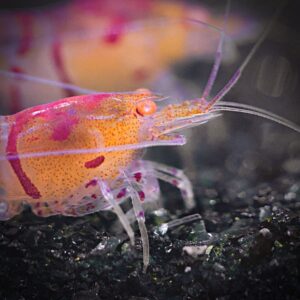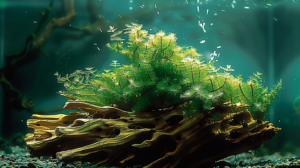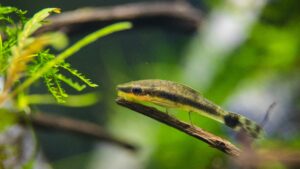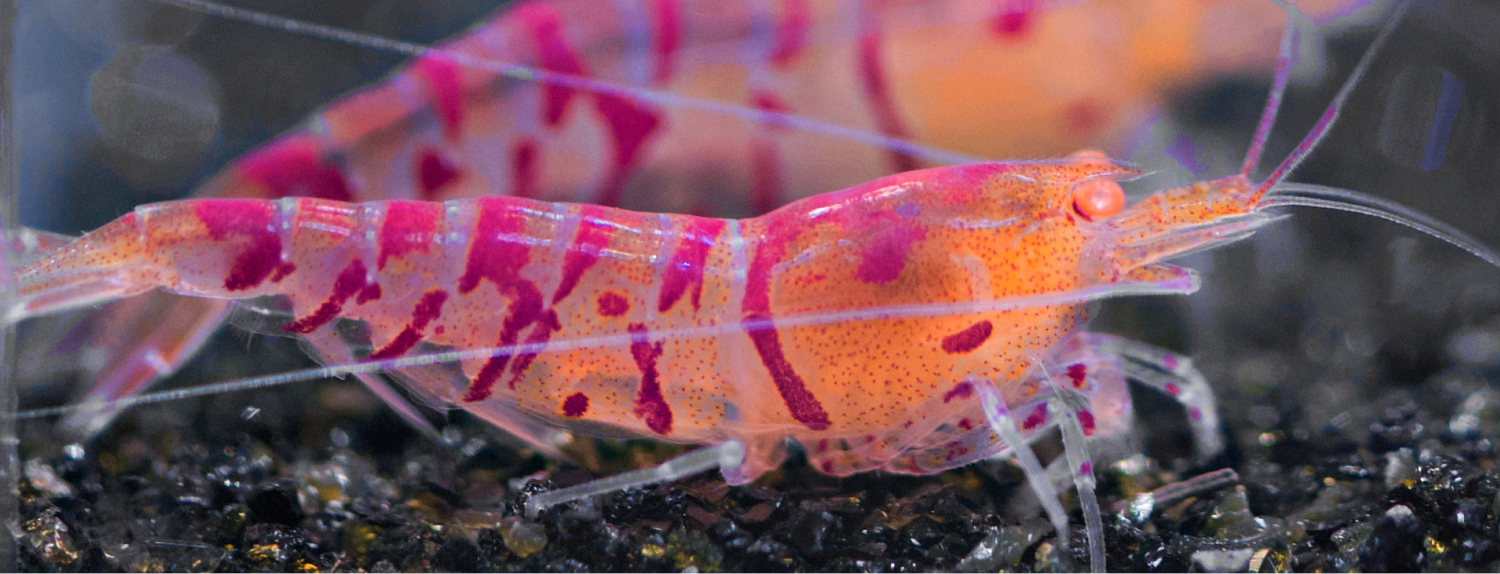The Caridina mariae tiger shrimp, often simply referred to as the tiger shrimp, is known for its striking and distinctive appearance. These small, freshwater shrimp feature a translucent body adorned with bold, tiger-like stripes in shades of red, orange, or black, making them highly attractive to aquarium enthusiasts.
 Scientific Name and Classification
Scientific Name and Classification
The scientific name of the tiger shrimp is Caridina mariae. This species belongs to the family Atyidae within the order Decapoda, which encompasses a diverse range of freshwater shrimp species.
Origin and Natural Habitat
Caridina mariae is native to the freshwater streams and rivers of Asia, particularly in regions of China and Taiwan. These shrimp thrive in clean, slow-moving waters with abundant plant life and leaf litter, providing them with ample hiding spots and foraging grounds.
Physical Appearance, Size, and Lifespan
Tiger shrimp are small, typically reaching an adult size of 1 to 1.5 inches (2.5 to 3.8 cm) in length. They have a semi-transparent body that showcases their vivid stripes and vibrant coloration. The lifespan of Caridina mariae tiger shrimp can range from 1.5 to 2 years under optimal conditions, though some individuals may live longer with meticulous care.
History of Caridina Mariae Tiger Shrimp
Development Through Selective Breeding
The popularity of Caridina mariae tiger shrimp in the aquarium hobby has led to extensive selective breeding. This process involves choosing shrimp with the most desirable traits, such as vibrant coloration and distinct stripe patterns, and breeding them to enhance these features over successive generations. This selective breeding has resulted in various color morphs and patterns, making them even more appealing to hobbyists.
Breeders have also begun incorporating patterns and color traits from the galaxy snowflake line to broaden the appeal of this family in mixed tanks. As a result, enthusiasts often compare how the caridina galaxy snowflake shrimp fare in different setups and how their unique markings relate to other established favorites.
Relation to Crystal Red Shrimp
Caridina mariae tiger shrimp are closely related to the Crystal Red Shrimp (Caridina cantonensis), another highly popular species among shrimp enthusiasts. Both species share similar care requirements and natural habitats, making them compatible tank mates in the aquarium. The crossbreeding of these two species has also led to the development of unique and visually stunning hybrid varieties such as the fancy tiger shrimp.
Popularity in the Aquarium Hobby
The tiger shrimp has gained immense popularity in the aquarium hobby due to its striking appearance and relatively straightforward care requirements. Hobbyists are drawn to their vibrant colors and active behavior, making them a dynamic addition to planted aquariums. Their ability to thrive in nano tanks also contributes to their widespread appeal, particularly among aquarists with limited space.
Caridina Mariae Tiger Shrimp Care and Ideal Water Parameters
To ensure the health and well-being of Caridina mariae tiger shrimp, maintaining ideal water parameters is crucial. These shrimp are sensitive to changes in water quality, so consistent monitoring and maintenance are necessary.
- Total Dissolved Solids (TDS): 100-120 ppm
- pH: 5.4-7.5
- General Hardness (GH): 4-5 dGH
- Carbonate Hardness (KH): 0-3 dKH
- Temperature: 60-77°F (15-25°C)
These parameters mimic the shrimp’s natural habitat, providing the necessary conditions for optimal growth, reproduction, and overall health. Regular water changes, proper filtration, and the avoidance of sudden parameter fluctuations are essential practices for maintaining a thriving Caridina mariae tiger shrimp population.
Setting Up a Successful Caridina Mariae Tiger Shrimp Tank
Tank Size Recommendations
For Caridina mariae tiger shrimp, a minimum tank size of 5 gallons (19 liters) is recommended. This allows sufficient space for the shrimp to explore and reduces the risk of water parameter fluctuations. Larger tanks of 10 gallons (38 liters) are preferable as they provide more stable environments and can support a larger shrimp population.
Filtration Options (Focus on Sponge Filters)
Sponge filters are highly recommended for shrimp tanks due to their gentle filtration and biological filtration capabilities. These filters provide a large surface area for beneficial bacteria to colonize, helping to maintain water quality. Additionally, sponge filters produce minimal water flow, which is ideal for the delicate nature of Caridina mariae tiger shrimp.
Substrate Choices
Choosing the right substrate is important for creating a conducive environment. Dark, fine-grained substrates such as ADA Aqua Soil or Fluval Stratum are preferred as they help mimic the shrimp’s natural habitat, enhance coloration, and support plant growth. These substrates also aid in maintaining stable water parameters by slightly buffering the pH.
 Importance of Hiding Places and Plants
Importance of Hiding Places and Plants
Providing plenty of hiding places is crucial for the well-being of tiger shrimp. They thrive in environments with abundant cover, which can be created using driftwood, rocks, and shrimp caves. Live plants such as Java moss, Anubias, and Java fern are excellent choices, offering shelter and surfaces for biofilm growth, a natural food source for shrimp.
Acclimation Process
Acclimating Caridina mariae tiger shrimp properly is essential to reduce stress and increase their chances of survival. The drip acclimation method is recommended:
- Float the shrimp bag in the tank for 15-20 minutes to equalize the temperature.
- Open the bag and gradually add small amounts of tank water over 1-2 hours.
- Gently release the shrimp into the tank using a net, avoiding adding bag water to the aquarium.
Diet and Feeding
Natural Feeding Habits
In the wild, Caridina mariae tiger shrimp are omnivores and scavengers, feeding on biofilm, algae, and detritus. Their diet consists of a variety of organic matter found in their natural habitats.
Recommended Commercial Foods
High-quality commercial shrimp foods formulated specifically for Caridina species are ideal. Brands such as Bacter AE, Shrimp King, and GlasGarten offer nutrient-rich options that support growth, color, and health.
Supplemental Foods (Vegetables, Leaves, etc.)
Supplemental foods like blanched vegetables (zucchini, spinach, and cucumber) and dried botanicals (Indian almond leaves, alder cones) are beneficial. These not only provide additional nutrients but also promote natural foraging behaviors.
Feeding Frequency and Amount
Feed Caridina mariae tiger shrimp sparingly to prevent overfeeding and water quality issues. A small amount of food, enough to be consumed within 2-3 hours, should be provided 2-3 times per week. Uneaten food should be removed promptly to maintain water quality.
Understanding Caridina Mariae Tiger Shrimp Grading
Basic Principles of Caridina Mariae Tiger Shrimp Grading
Grading Caridina mariae tiger shrimp involves evaluating their coloration, stripe pattern, and overall health. Higher-grade shrimp exhibit more vivid colors and well-defined, uniform stripes. The grading system helps breeders and hobbyists identify and select the best specimens for breeding and sale.
Importance of Grading in Breeding and Sales
Grading is crucial for maintaining high standards in shrimp breeding. It ensures that desirable traits are passed on to future generations and helps hobbyists understand the quality and value of the shrimp they purchase. High-grade shrimp often command higher prices and are sought after by collectors and breeders.
Color Grading
Description of Different Color Grades
Color grading in Caridina mariae tiger shrimp is an essential aspect of understanding their value and appeal. The grading system typically includes the following categories:
- G3: These shrimp have lighter, less intense colors with more transparent areas on their bodies.
- G2: Mid-grade shrimp show more solid and consistent colors but may still have some lighter or transparent patches.
- G1: High-grade shrimp exhibit deep, vibrant colors with minimal transparency. The colors are solid and uniformly distributed.
- G0: Competition grade shrimp display the most intense and saturated colors with a flawless, uniform appearance, making them highly prized among breeders and collectors.
Factors Affecting Color Intensity
Several factors influence the color intensity of Caridina mariae tiger shrimp:
- Genetics: The primary determinant of color intensity is the shrimp’s genetic background.
- Diet: High-quality foods rich in carotenoids and other color-enhancing nutrients can enhance coloration.
- Water Parameters: Stable and optimal water conditions promote better coloration.
- Lighting: Proper aquarium lighting can highlight and intensify the shrimp’s natural colors.
- Stress Levels: Low-stress environments help maintain vibrant colors, as stress can cause shrimp to lose their intensity.
Breeding Caridina Mariae Tiger Shrimp
Breeding Setup Requirements
A successful breeding setup for Caridina mariae tiger shrimp includes:
- Tank Size: A separate breeding tank of at least 10 gallons is recommended.
- Water Parameters: Maintain optimal conditions (TDS 100-120, pH 5.4-6.2, GH 4-5, KH 0-1, temperature 60-72°F).
- Filtration: Use a sponge filter to provide gentle filtration and prevent fry from being sucked into the filter.
- Substrate and Plants: Use a fine, dark substrate and provide plenty of live plants, moss, and hiding spots to mimic their natural habitat.
Mating BehaviorCaridina mariae tiger shrimp exhibit interesting mating behaviors. When a female is ready to mate, she releases pheromones into the water to attract males. Males will actively swim around the tank searching for the receptive female. Once found, the male will mate with the female, who will then carry the fertilized eggs under her abdomen.
Egg Development and Hatching
The female tiger shrimp carries the eggs for about 3-4 weeks. During this period, she will regularly fan the eggs with her pleopods to keep them oxygenated and clean. The eggs will gradually change color from a translucent white to a more opaque shade as they develop. Once the eggs hatch, tiny, fully-formed shrimplets emerge.
Care for Shrimplets
Caring for shrimplets requires maintaining optimal water conditions and providing suitable food. Newly hatched shrimplets feed on biofilm, so ensuring a mature tank with plenty of biofilm is crucial. Supplement their diet with finely powdered shrimp food and blanched vegetables. Regular water changes and careful monitoring of water parameters are essential to ensure their healthy growth and development.
Common Health Issues and Treatments
Signs of Stress or Illness
Monitoring your Caridina mariae tiger shrimp for signs of stress or illness is crucial for maintaining their health. Common signs include:
- Loss of color or dulling of vibrant hues
- Lethargy or reduced activity
- Difficulty molting or incomplete molts
- Unusual swimming patterns or constant hiding
- Visible parasites or spots on the body
Common Diseases and Parasites
Caridina mariae tiger shrimp are susceptible to various diseases and parasites, including:
- Bacterial Infections: Manifest as white or red patches on the shrimp’s body. Commonly caused by poor water quality.
- Fungal Infections: Appear as cotton-like growths on the body or legs. Often a secondary infection following an injury or stress.
- Vorticella: A parasitic infection that looks like white fuzz or tiny threads on the shrimp. It can spread quickly if not treated.
- Ellobiopsidae: Green or yellowish growths usually found under the carapace or on the legs. This parasite is often fatal if not promptly addressed.
Prevention and Treatment Options
Preventing health issues involves maintaining optimal water conditions, providing a balanced diet, and avoiding overcrowding. Treatments for common issues include:
- Bacterial Infections: Use antibacterial medications like Maracyn or Kanaplex. Ensure good water quality with regular changes.
- Fungal Infections: Treat with antifungal medications and improve water conditions.
- Vorticella: A salt bath (1 tablespoon of salt per gallon of water) can help. Ensure the shrimp are only in the bath for a short duration, around 30 minutes.
- Ellobiopsidae: Unfortunately, there is no effective treatment for this parasite. The best course of action is to isolate infected shrimp to prevent the spread.
Compatible Tank Mates
Suitable Shrimp Species
Caridina mariae tiger shrimp can cohabit peacefully with other shrimp species, especially those with similar care requirements. Suitable shrimp species include:
- Crystal Red Shrimp (Caridina cantonensis)
- Bee Shrimp (Caridina cantonensis var. bee)
- Snowball Shrimp (Neocaridina zhangjiajiensis)
 Compatible Fish Species
Compatible Fish Species
Selecting the right fish species is important to ensure they do not prey on the shrimp. Compatible fish include (there is always the danger of fish eating shrimp lets):
- Small tetras (e.g., Ember Tetras)
- Otocinclus Catfish
- Pygmy Corydoras
- Small Rasboras (e.g., Chili Rasboras)
Species to Avoid
Avoid keeping Caridina mariae tiger shrimp with larger or aggressive fish that may prey on them. Species to avoid include:
- Cichlids
- Bettas
- Larger barbs
- Goldfish
*No fish are not recommended in a breeding colony.
FAQs
Can Caridina Mariae Tiger Shrimp Be Kept with Crystal Red Shrimp?
Yes, Caridina mariae tiger shrimp can be kept with Crystal Red Shrimp. They have similar water parameter requirements and generally coexist peacefully. Crossbreeding may occur, leading to interesting hybrid offspring.
Can Caridina Mariae Tiger Shrimp Be Kept with Fish?
Caridina mariae tiger shrimp can be kept with small, peaceful fish that do not view shrimp as prey. Suitable choices include small tetras, Otocinclus Catfish, and Pygmy Corydoras. Fish are not recommended when attempting a breeding colony.
How Long Do Caridina Mariae Tiger Shrimp Live?
Caridina mariae tiger shrimp typically live for 1.5 to 2 years, though with optimal care, some individuals may live slightly longer.
How Often Do Caridina Mariae Tiger Shrimp Molt?
Molting frequency depends on the shrimp’s age and growth rate. Juveniles may molt every few days to a week, while adults typically molt once every 3-4 weeks. Proper water conditions and a nutrient-rich diet support healthy molting cycles.
What Causes Caridina Mariae Tiger Shrimp to Lose Color?
Color loss in Caridina mariae tiger shrimp can result from several factors:
- Stress: Changes in environment, poor water quality, or aggressive tank mates can cause stress.
- Inadequate Diet: Lack of proper nutrients can lead to dull coloration.
- Water Conditions: Suboptimal parameters, such as incorrect pH or hardness, can affect color vibrancy.
- Age: As shrimp age, they may naturally lose some of their coloration.
Maintaining stable, optimal water conditions and providing a high-quality, varied diet can help prevent color loss.
Buying Guide
How to Spot Healthy Shrimp
When purchasing Caridina mariae tiger shrimp, look for the following signs of health:
- Active Behavior: Healthy shrimp are active and constantly foraging. Avoid shrimp that appear lethargic or inactive.
- Vibrant Colors: The shrimp should have bright, clear colors without any discoloration or opaque patches.
- Clear Exoskeleton: A healthy shrimp has a smooth, intact exoskeleton without any cracks or damage.
- Clean Legs and Antennae: The legs and antennae should be intact and free from any growths or parasites.
- No Visible Parasites or Fungi: Check for any signs of vorticella (white fuzz) or fungal infections.
Selecting the Best Specimens
To select the best Caridina mariae tiger shrimp, consider:
- Grading: Choose shrimp with higher grades for more intense colors and well-defined patterns.
- Size: Larger shrimp are generally more mature and likely to be in good health.
- Behavior: Select shrimp that are actively exploring and foraging in the tank.
- Genetics: If possible, inquire about the shrimp’s lineage to ensure strong genetic traits.
Reputable Sources for Purchasing Caridina Mariae Tiger Shrimp
Buy from reputable breeders or suppliers known for their high-quality shrimp. Consider:
- Local Fish Stores (LFS): A good LFS with a focus on freshwater shrimp can be a reliable source.
- Online Breeders: Reputable online breeders and sellers with positive reviews and a track record of healthy shipments. Select reputable lineages carefully. To ensure consistent offspring and predictable gene inheritance when starting a breeding colony, use purebred or near purebred lineages, avoiding genes from other variants.
- Shrimp Clubs and Forums: Joining shrimp-keeping communities can provide recommendations and direct purchases from trusted breeders.
Shipping Considerations
When ordering shrimp online, consider these shipping tips:
- Weather: Avoid extreme temperatures during shipping. Spring and fall are generally the best seasons for shipping shrimp.
- Packaging: Ensure the seller uses proper packaging techniques, such as insulated boxes and heat/cool packs as needed.
- Transit Time: Choose express shipping options to minimize transit time and stress on the shrimp.
- Acclimation Instructions: Follow the seller’s acclimation instructions carefully upon receiving the shrimp.
Advanced Caridina Mariae Tiger Shrimp Keeping
Selective Breeding Techniques
Selective breeding involves choosing shrimp with desirable traits (e.g., color, pattern) and breeding them to enhance these traits in future generations. Steps include:
- Isolate Desired Traits: Set up separate breeding tanks for shrimp with the desired traits.
- Monitor Offspring: Regularly monitor the offspring and select the best specimens for further breeding.
- Maintain Records: Keep detailed records of pairings and offspring results to track genetic progress.
Creating Unique Color Morphs
To create unique color morphs:
- Crossbreeding: Crossbreed Caridina mariae tiger shrimp with other Caridina species, such as Crystal Red Shrimp, to produce new color patterns and morphs.
- Backcrossing: Breed the offspring back to one of the parent species to stabilize and enhance the desired traits.
- Mutation Selection: Occasionally, genetic mutations may result in new color morphs. Select and breed these unique specimens to develop stable lines.
Participating in Shrimp Competitions
Engaging in shrimp competitions can be rewarding:
- Join Shrimp Clubs: Many shrimp clubs and societies hold competitions and can provide guidelines and entry information.
- Prepare Specimens: Select and prepare your best shrimp specimens according to competition standards.
- Presentation: Ensure shrimp are healthy, vibrant, and displayed in clean, well-maintained tanks.
- Network: Use competitions to network with other breeders, exchange knowledge, and gain recognition for your breeding efforts.










